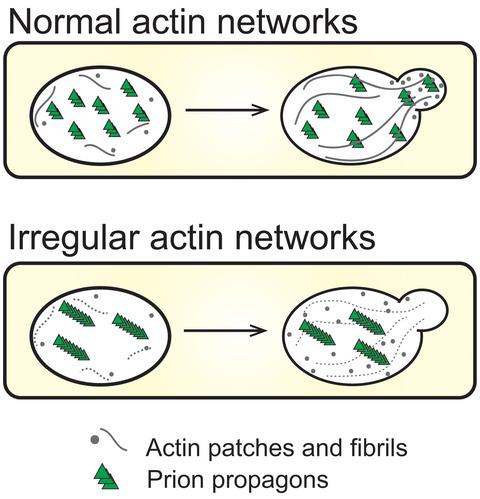当前位置:
X-MOL 学术
›
Mol. Microbiol.
›
论文详情
Our official English website, www.x-mol.net, welcomes your feedback! (Note: you will need to create a separate account there.)
The actin cytoskeletal network plays a role in yeast prion transmission and contributes to prion stability.
Molecular Microbiology ( IF 3.6 ) Pub Date : 2020-05-19 , DOI: 10.1111/mmi.14528 Jane E Dorweiler 1 , Mitchell J Oddo 1 , Douglas R Lyke 1 , Jacob A Reilly 1 , Brett T Wisniewski 1 , Emily E Davis 1 , Abigail M Kuborn 1 , Stephen J Merrill 2 , Anita L Manogaran 1
Molecular Microbiology ( IF 3.6 ) Pub Date : 2020-05-19 , DOI: 10.1111/mmi.14528 Jane E Dorweiler 1 , Mitchell J Oddo 1 , Douglas R Lyke 1 , Jacob A Reilly 1 , Brett T Wisniewski 1 , Emily E Davis 1 , Abigail M Kuborn 1 , Stephen J Merrill 2 , Anita L Manogaran 1
Affiliation

|
Chaperone networks are required for the shearing and generation of transmissible propagons from pre‐existing prion aggregates. However, other cellular networks needed for maintaining yeast prions are largely uncharacterized. Here, we establish a novel role for actin networks in prion maintenance. The [PIN+] prion, also known as [RNQ+], exists as stable variants dependent upon the chaperone machinery for the transmission of propagons to daughter cells during cell division and cytoplasmic transfer. Loss of the Hsp104 molecular chaperone leads to the growth of prion particles until they are too large to be transmitted. Here, we isolated a unique [PIN+] variant, which is unstable in actin mutants. This prion loss is observed over many generations, and coincides with the detection of both high molecular weight species of Rnq1 and large visible aggregates that are asymmetrically retained during cell division. Our data suggest that the irregular actin networks found in these mutants may influence propagon number by slowly permitting aggregate growth over time, resulting in the generation of nontransmissible large aggregates. Thus, we show the potential contribution of cytoskeletal networks in the transmission of prion propagons, which parallels models that have been proposed for cell‐to‐cell transmission of small amyloids in neurodegenerative protein aggregation diseases.
中文翻译:

肌动蛋白细胞骨架网络在酵母病毒的传播中起作用,并有助于病毒的稳定性。
分子伴侣网络是需要的,以便从现有的the病毒聚集体中剪切和产生可传播的丙烯。然而,维持酵母蛋白所需的其他细胞网络在很大程度上尚未表征。在这里,我们建立了肌动蛋白网络在病毒维护中的新角色。[ PIN + ] ion病毒,也称为[ RNQ + ],作为稳定的变体存在,取决于分子伴侣在细胞分裂和细胞质转移过程中将丙烷传递给子细胞的伴侣机制。Hsp104分子伴侣的损失导致of病毒颗粒的生长,直到它们太大而无法传播为止。在这里,我们隔离了一个唯一的[ PIN +]变体,在肌动蛋白突变体中不稳定。病毒的损失已经历了许多世代,并且与Rnq1的高分子量物种和细胞分裂过程中不对称保留的大型可见聚集体的检测相吻合。我们的数据表明,在这些突变体中发现的不规则肌动蛋白网络可能会随着时间的流逝缓慢允许聚集体生长,从而影响脯氨酸的数量,从而导致产生不可传播的大聚集体。因此,我们显示了sk病毒丙agon传播中的细胞骨架网络的潜在贡献,这与已经提出的在神经退行性蛋白质聚集疾病中小淀粉样蛋白的细胞间传播的模型相似。
更新日期:2020-05-19
中文翻译:

肌动蛋白细胞骨架网络在酵母病毒的传播中起作用,并有助于病毒的稳定性。
分子伴侣网络是需要的,以便从现有的the病毒聚集体中剪切和产生可传播的丙烯。然而,维持酵母蛋白所需的其他细胞网络在很大程度上尚未表征。在这里,我们建立了肌动蛋白网络在病毒维护中的新角色。[ PIN + ] ion病毒,也称为[ RNQ + ],作为稳定的变体存在,取决于分子伴侣在细胞分裂和细胞质转移过程中将丙烷传递给子细胞的伴侣机制。Hsp104分子伴侣的损失导致of病毒颗粒的生长,直到它们太大而无法传播为止。在这里,我们隔离了一个唯一的[ PIN +]变体,在肌动蛋白突变体中不稳定。病毒的损失已经历了许多世代,并且与Rnq1的高分子量物种和细胞分裂过程中不对称保留的大型可见聚集体的检测相吻合。我们的数据表明,在这些突变体中发现的不规则肌动蛋白网络可能会随着时间的流逝缓慢允许聚集体生长,从而影响脯氨酸的数量,从而导致产生不可传播的大聚集体。因此,我们显示了sk病毒丙agon传播中的细胞骨架网络的潜在贡献,这与已经提出的在神经退行性蛋白质聚集疾病中小淀粉样蛋白的细胞间传播的模型相似。


























 京公网安备 11010802027423号
京公网安备 11010802027423号